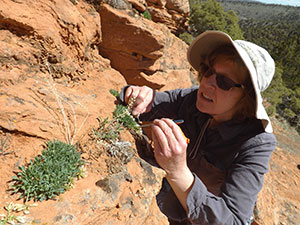
Contact Us
Institutional Communications
Bureau of Mines Building, Room 137
Laramie, WY 82071
Phone: (307) 766-2929
Email: cbaldwin@uwyo.edu
UW Researchers Gain Insights Into Rare Clover in Foothills of Wind Rivers
Published September 11, 2023

UW researcher Joy Handley hand-pollinates Barneby’s Clover, a rare plant found
only in rocky outcrops of the foothills and rims along the eastern slope of Wyoming’s
Wind River Mountains. (Lusha Tronstad Photo)
A rare plant found only in rocky outcrops of the foothills and rims along the eastern slope of Wyoming’s Wind River Mountains likely persists because it blooms for a relatively long period of two months, according to newly published research by University of Wyoming scientists.
Barneby’s Clover, a small, mat-forming plant, is found in areas where most other plants can’t grow, such as in crevices of rocks and in thin layers of soil on top of bedrock. It depends upon bees and other pollinators to produce viable seeds, leading to concerns that a warming climate could cause a mismatch between the blooming period and insect appearance.
But researchers Joy Handley and Lusha Tronstad, of the Wyoming Natural Diversity Database at UW, found that the two-month period of blooming -- between April and June -- has likely helped Barneby’s Clover maintain its niche in the rugged sandstone bedrock of Red Canyon and nearby locations in the vicinity of Lander. Their research appears in the Nordic Journal of Botany.
“… (T)he two-month window that this species blooms likely enables the plant to maintain genetic diversity through later-blooming individuals,” they wrote.
The relatively long period of blooming results from the fact that Barneby’s Clover grows in a diverse network of crevices with different exposure to sun and moisture.
“The variations in topography and microhabitats can promote the persistence of a species by extending peak blooming time within the species distribution and providing an array of soil depths and fertility, as well as moisture retention and daily shade,” the researchers wrote.
Handley and Tronstad conducted their research between 2018 and 2021, monitoring the plant’s growth at five locations. They also conducted experiments at three locations to measure the degree to which pollinating insects influenced seed production. Additionally, they trapped bees and examined the pollen carried by the insects.
Their conclusion is that Barneby’s Clover does not self-pollinate, relying on pollinators -- primarily the Andrena genus of bee -- to produce seeds.
“The number and mass of viable seeds per flower, and the number of bees captured increased as the season progressed, indicating that more and larger seeds were made when more pollinators were present,” they wrote. “… (W)e observed much higher seed production in later-blooming plants.”
Previous research has shown that rare plants may be especially vulnerable to declining pollinators -- and that, as temperatures rise, the life cycles of plants and pollinators may become mismatched. For now, Barneby’s Clover is holding its own as the climate warms. But the UW researchers say its future is not guaranteed.
“A mismatch in timing between blooming and pollinating insect emergence could limit seed production in (Barneby’s Clover) if plants bloom earlier over time and bee emergence does not follow the same phenology,” they wrote. “Rare plants can be pollinated by rare pollinators, showing that conserving these pollinators is crucial for rare plants and early-blooming species may be higher at risk.”
Contact Us
Institutional Communications
Bureau of Mines Building, Room 137
Laramie, WY 82071
Phone: (307) 766-2929
Email: cbaldwin@uwyo.edu
